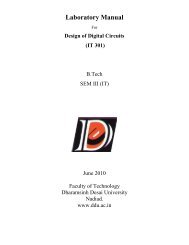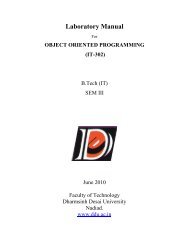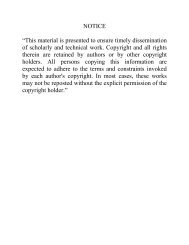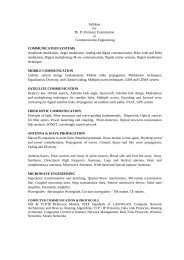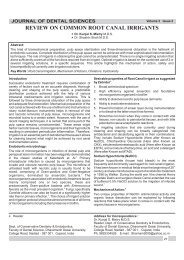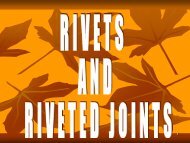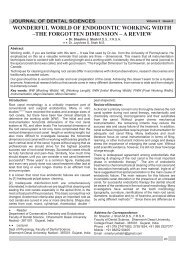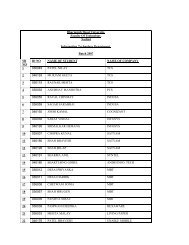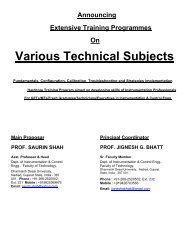Syllabi Book - Dharmsinh Desai University
Syllabi Book - Dharmsinh Desai University
Syllabi Book - Dharmsinh Desai University
You also want an ePaper? Increase the reach of your titles
YUMPU automatically turns print PDFs into web optimized ePapers that Google loves.
<strong>Syllabi</strong> <strong>Book</strong><br />
For<br />
Post Graduate Course of<br />
Instrumentation & Control Engineering<br />
Department of Instrumentation & Control Engineering<br />
Faculty of Technology<br />
<strong>Dharmsinh</strong> <strong>Desai</strong> <strong>University</strong><br />
Nadiad – 387 001, Gujarat, India.<br />
http://www.ddu.ac.in
M.Tech. - SEMESTER I-IV (INSTRUMENTATION & CONTROL)<br />
Course Structure and Scheme of Evaluation (Semester-wise)<br />
Subject Name of Subject Hrs./Week Prac Evaluations (Marks)<br />
Code<br />
L Tut. Ses. Th. Pra T/W Total<br />
SEM-I (800 marks)<br />
Digital Signal Processing 3 1 2 40 60 25 25 150<br />
Elective 1<br />
Modern Control theory/Virtual 3 1 2 40 60 25 25 150<br />
Instrumentation<br />
Process Sensors & Controllers 3 1 2 40 60 25 25 150<br />
Advanced Power Electronics 3 1 2 40 60 25 25 150<br />
Advanced Microprocessors & Micro<br />
controllers 3 1 2 40 60 25 25 150<br />
Seminar-I - 2 - - - - 50 50<br />
Total 15 7 10 200 300 125 175 800<br />
SEM-II (800 marks)<br />
Elective 1<br />
Bio Medical Systems & Control / 3 1 2 40 60 25 25 150<br />
Orthopedic Mechanics<br />
Advanced Process 3 1 2 40 60 25 25 150<br />
Instrumentation<br />
Elective 2 3 1 2 40 60 25 25 150<br />
Power Electronics System design /<br />
Nano Technology & Nano Sensors<br />
Neural networks & Fuzzy Logic<br />
control<br />
3 1 2 40 60 25 25 150<br />
3 1 2 40 60 25 25 150<br />
Seminar-II - 2 - - - - 50 50<br />
Total 15 7 10 200 300 125 175 800<br />
SEM-III (450 marks)<br />
Project (Phase-I) - 24 - - - 225 125 350<br />
Seminar-III - 6 - - - - 50 50<br />
Total 30 225 175 400<br />
SEM-IV (450 marks)<br />
Project (Phase-II) - 24 - - - 300 150 450<br />
Seminar-IV - 6 - - - - 50 50<br />
Total - 30 - - - 300 200 500<br />
(Total marks = 800+800+400+500=2500)
M. Tech. Sem. I<br />
SYLLABUS & SCHEME FOR THE SUBJECT<br />
DIGITAL SIGNAL PROCESSING<br />
Teaching Scheme (H/W) Exam Scheme (Marks)<br />
Lectures Tutorial Practical Theory Sessional Practical T/W Total<br />
(3 hrs) (1 hr)<br />
3 1 2 60 40 25 25 150<br />
Syllabus Details:<br />
Introduction, Discrete Signals, Discrete Time Systems,<br />
Discrete Convolution, Analog Filters, Discrete-Time,<br />
Fourier Transform, The DFT & FFT,<br />
The Z-Transform Applications of z Transform,<br />
IIR Digital Filters, FIR Digital Filters<br />
Text <strong>Book</strong>s:<br />
i. Analog & Digital Signal Processing<br />
[Second Edition] by Ashok Ambardar<br />
<strong>Book</strong>s/Cole Publishing Co.<br />
Reference <strong>Book</strong>s:<br />
i. Distance Signal Matlab<br />
By Vinay Hingday & John Prokis<br />
Prentice Hall of India, New Delhi.<br />
ii. Matlab Programming for Engineers By Chapman (second edition)
M. Tech. Sem. I<br />
Elective 1<br />
SYLLABUS & SCHEME FOR THE SUBJECT<br />
MODERN CONTROL THEORY<br />
Teaching Scheme (H/W) Exam Scheme (Marks)<br />
Lectures Tutorial Practical Theory Sessional Practical T/W Total<br />
(3 hrs) (1 hr)<br />
3 1 2 60 40 25 25 150<br />
Introduction<br />
Controller Modes & Control Actions, Digital Controllers, Control loop Characteristics,<br />
Model Control<br />
Controllable & Observable companion forms, Pole placement by state feedback, full order<br />
observers, Dead bit observers.<br />
Optimal Control<br />
Formation of Optimal Control Problem, Calculus of variations, minimum principle, Dynamic<br />
programming, Numerical solution of two point boundary value problem.<br />
Optimal Feedback Control<br />
Discrete time linear state regulator, time in-variant linear state regulators, Numerical solution<br />
of the Riccatie equation, Minimum time control of linear time in-variant system.<br />
Stochastic Optimal Linear estimation & Control<br />
Stochastic Processes and linear system, optimal estimation or linear continuous time system<br />
and linear discrete time system, Stochastic Optimal Linear regulator<br />
Adaptive Control<br />
Input adaptation, Model adaptive systems, Identifications function, Identification time<br />
requirement of an Ideal identification scheme, the decision function, indices of<br />
performance, A stability of Adaptive control system, certain aspects of learning system.<br />
Text <strong>Book</strong>s:<br />
i. Non linear Automatic Control by J.E. Gibson, McGraw Hill Publication.<br />
ii. Modern Control System Theory by M. Gopal (2 nd Edition), Wiley Eastern<br />
Publicaton.<br />
iii. Process Control Instrumentation Technology by Curtis Johnson (4 th Edition), PHI.<br />
Reference books:<br />
i. Modern Control System Theory By J.T. Tou, McGraw Hill Publication.<br />
ii. Modern Control Engineering By Ogata (2 nd Edition), Prentice-Hall<br />
India. Note: * indicate Lab Tutorial
M. Tech. Sem.I<br />
Elective 1<br />
SYLLABUS & SCHEME FOR THE SUBJECT<br />
VIRTUAL INSTRUMENTATION<br />
Teaching Scheme (H/W) Exam Scheme (Marks)<br />
Lectures Tutorial Practical Theory Sessional Practical T/W Total<br />
(3 hrs) (1 hr)<br />
3 1 2 60 40 25 25 150<br />
TEXTBOOKS:<br />
Virtual Instrumentation: Historical perspective, advantages, blocks diagram and<br />
architecture of a virtual instrument, data-flow techniques, graphical programming in data flow,<br />
comparison with conventional programming. Development of Virtual Instrument using GUI,<br />
Real-time systems<br />
VI programming techniques: VIS and sub-VIS, loops and charts, arrays, clusters and graphs, case and<br />
sequence structures, formula nodes, local and global variables, string and file I/O.<br />
Data acquisition basics: Introduction to data acquisition on PC, Sampling fundamentals,<br />
Input/output techniques and buses. ADC, DAC, Software and hardware installation,<br />
Calibration, Resolution, Data acquisition interface requirements.<br />
LabVIEW Hardware: VI Chassis requirements Common Instrument Interfaces: Current loop,<br />
RS 232, GPIB.PCI card communication, NI DAQ MAX<br />
LabVIEW Control Design Toolbox:<br />
Creating continuous-time (s-)transfer functions<br />
Creating discrete-time (z-)transfer functions<br />
Creating continuous-time state-space models<br />
Creating discrete-time state-space models<br />
Standard transfer functions<br />
PID controllers<br />
Writing models to file. Reading models from file<br />
Getting information about a model<br />
Converting Control Design models to/from Simulation Module models<br />
Calculating transfer functions from state-space models<br />
Discretizing continuous-time models<br />
Simulation (time responses)<br />
Frequency response Analysis<br />
1. Virtual Instrumentation using LabVIEW by Sanjeev Gupta<br />
2. Introduction to LabVIEW Control Design Toolkit 1.0 by Finn Haugen<br />
3. LabVIEW Basic 1 & Basic 2 course guide by National Instruments<br />
REFERENCES:<br />
1. LabVIEW 8 : Authors and Organization:Robert Bishop, <strong>University</strong> of Texas,<br />
Austin Publisher: Prentice Hall ISBN-13: 9780138004606<br />
2. LabVIEW 2009:Authors and Organization:Robert Bishop, <strong>University</strong> ofTexas at<br />
Austin Publisher: Prentice HallISBN-13: 9780132141291<br />
WEB RESOURCES:www.ni.com
M. Tech. Sem. I<br />
SYLLABUS & SCHEME FOR THE SUBJECT<br />
PROCESS SENSORS & CONTROLLERS<br />
Teaching Scheme (H/W) Exam Scheme (Marks)<br />
Lectures Tutorial Practical Theory Sessional Practical T/W Total<br />
(3 hrs) (1 hr)<br />
3 1 2 60 40 25 25 150<br />
Process Sensors<br />
Sensors for Temperature, Pressure, Flow, Level, Stress, Strain, Phototubes, Photodiodes, Photovoltaic<br />
and photoconductive cells, Laser, Displacement transducers, Accelerometers, Smart Transmitter &<br />
SMART Sensors<br />
Application of sensors: displacement, velocity, acceleration, force, stress, strain, pressure,<br />
temperature, flow, level and laser.<br />
Process Controllers & Actuators<br />
Multi-variable control systems, Pneumatic, Hydraulic & Electrical Actuators, Control Valves.<br />
Process Control Networks<br />
SCADA, DCS, Fieldbus, Foundation Fieldbus, wireless sensors<br />
Text <strong>Book</strong>s:<br />
i. Process Control Instrumentation Technology by Curtis Johnson, 4 th Edition, PHI.<br />
ii. The Condensed Handbook of Measurement and Control by N. E. Battikha, 3 rd Edition, ISA<br />
iii. Fieldbuses for Process Control: Engineering, Operation and Maintenance, Jonas Berge, ISA<br />
iv. Foundation field bus by Ian Verhappen and Augusto Pereira, 2 nd Edition, ISA<br />
v. SCADA: Supervisory Control and Data Acquisition, Stuart A. Boyer, 3 rd Edition, ISA<br />
Reference books:<br />
i. Process Instrumentation and controls Handbook (3 rd Edition) by Douglus M. Considine,<br />
McGraw Hill <strong>Book</strong> Company.<br />
ii. Industrial Control Handbook Volume-I Transducers by E.A. Parre, Collins, London.<br />
iii. A course in Mechanical measurement & Instrumentation by A.K. Sawhney, Dhanpat Rai &<br />
Sons, Delhi.<br />
iv. Advanced PID Control, Karl J. Astrom and Tore Hagglund, ISA<br />
v. Automation Network Selection by Dick Caro, 2 nd Edition, ISA
M. Tech. Sem. I<br />
SYLLABUS & SCHEME FOR THE SUBJECT<br />
ADVANCED POWER ELECTRONICS<br />
Teaching Scheme (H/W) Exam Scheme (Marks)<br />
Lectures Tutorial Practical Theory Sessional Practical T/W Total<br />
(3 hrs) (1 hr)<br />
3 1 2 60 40 25 25 150<br />
Characteristics of modern power semiconductor devices<br />
Characteristics of Power Semiconductor Devices (PSDs) like Thyristors, GTOs, MOSFETs, IGBTS, MCS<br />
and their static & switching characteristics., Device protection & Design of snubber circuits.<br />
Converters<br />
Principle of Inversion & Analysis of different Inverter circuits with various load.<br />
Principle of choppers & Analysis of different Chopper circuits with various load.<br />
Pulse width modulated Inverters<br />
Resonant pulse Inverters & analysis.<br />
DC-DC Switch mode converters<br />
Analysis of various regulator circuits.<br />
DC Drive<br />
Single phase Drives<br />
Three phase Drives<br />
Chopper phase Drives<br />
Closed loop control of DC device<br />
AC Drive<br />
Induction motor drives<br />
Synchronous motor drives<br />
Text <strong>Book</strong>s:<br />
i. Power Electronics, Circuits, Devices & Applications by Muhammad H. Rashid (2 nd Edition), PHI<br />
publication.<br />
ii. Power Electronics, Devices & Circuits by C.M. Pauddar, Jain brothers, New Delhi.<br />
Reference books:<br />
i.<br />
ii.<br />
Power Electronics by P.C. Sen, Wheeler Publication Company, New Delhi.<br />
Power Electronics, Converters, Applications & Design by Mohan, Undeland & Robbins,<br />
Wiley Eastern Ltd., New York.
M. Tech. Sem. I<br />
SYLLABUS & SCHEME FOR THE SUBJECT<br />
ADVANCED MICROPROCESSORS & MICRO CONTROLLERS<br />
Teaching Scheme (H/W) Exam Scheme (Marks)<br />
Lectures Tutorial Practical Theory Sessional Practical T/W Total<br />
(3 hrs) (1 hr)<br />
3 1 2 60 40 25 25 150<br />
Advanced Microprocessor & Micro controllers<br />
Introduction to the microprocessor and computer. The microprocessor and its architecture.Addressing<br />
modes, Data movement Instructions. Arithmetic and logic Instructions. Program control Instructions, Programming<br />
the Microprocessor. 8086/8088 hardware specifications. Memory Interface. Basic I/O interface. Interrupts. Direct<br />
memory Access and DMA controlled I/O. The Arithmetic Co processor. Bus Interface. The 80186, 80188 and 80286<br />
Microprocessors. the 80386 and 80486 Microprocessors. The Pentium and Pentium pro Microprocessors Introduction to<br />
PIC 16F84 microcontroller<br />
.<br />
Text <strong>Book</strong>s:<br />
1. The Intel Microprocessors: 8086 / 8088, 80186 / 80188 , 80286 , 80386,80486,<br />
Pentium and Pentium Pro processor – Architecture , Programming , and Interfacing<br />
4 th edition By: B. Brey.<br />
2. Easy Micrcontrol'n (formerly Easy Pic'n) : By Davis Benson , From Square – 1, version 4.1.<br />
Reference <strong>Book</strong>s:<br />
1. Fundamentals of Microprocessors and Micro Computers by B. Ram (4 th Edition,1994)<br />
Dhanpatrai & Sons.<br />
2. PIC Microcontrollers : by Di Jasio, Wilmshurst, Ibrahim, Morton, Bates, J. Smith, D.W. Smith,<br />
Hellebuyck, from Newnes
M. Tech. Sem. I<br />
SYLLABUS & SCHEME FOR THE SUBJECT<br />
SEMINAR-I<br />
Teaching Scheme (H/W) Exam Scheme (Marks)<br />
Lectures Tutorial Practical Theory Sessional Practical T/W Total<br />
(3 hrs) (1 hr)<br />
- 2 - - - - 50 50<br />
Seminar I<br />
Each student will be required to submit one term paper about the trends in the subject chosen in<br />
consultation with faculty. He/She has to present a seminar intermittently regarding the progress of<br />
his/her studies.
M. Tech. Sem. II<br />
Elective 1<br />
SYLLABUS & SCHEME FOR THE SUBJECT<br />
BIOMEDICAL SYSTEMS AND CONTROL<br />
Teaching Scheme (H/W) Exam Scheme (Marks)<br />
Lectures Tutorial Practical Theory Sessional Practical T/W Total<br />
(3 hrs) (1 hr)<br />
3 1 2 60 40 25 25 150<br />
A. Introduction to Biomedical Instrumentation<br />
1. Bio electric signals & their measurements<br />
2. Pulmonary function analysers, Blood gas analysers & oximeters<br />
3. Blood flow and Blood pressure measurement<br />
4. Foetal monitoring instruments<br />
5. Arrhythmia & ambulatory Monitoring instruments<br />
6. Magnetic resonance imaging system<br />
7. Cardiac pacemakers, Cardiac Defibrillators<br />
8. Hemodialysis machine<br />
9. Ultrasonic Imaging system<br />
10. Surgical diathermy & various diathermy applications. LASER in bio medical<br />
B. Biomedical systems and Control<br />
1. Model and Analog study of Biological system<br />
2. Resistive property, Compliance property,<br />
3. System response, System stability<br />
4. Feedback concept and control mathematics<br />
5. Regulation of body temperature<br />
6. Cardiovascular control system<br />
Text and Ref books:<br />
1. System approach to Biomedicine by W.B. Blessor, McGrawhill<br />
2. Human Physiology by Vander, Shermon & Lucieno, Latest Eastern Edition<br />
3. IEEE transcation on BME<br />
4. Physiological control systems: Analysis, Simulation Estimation. By:<br />
Michael C.K.Khoo. Pub: Prentice Hall of India Pvt. Ltd. New Delhi.<br />
5. Handbook of bio medical instrumentation by R.S. Khandpur, Tata McGraw<br />
Hill <strong>Book</strong> Publishing company, New Delhi<br />
6. Biomedical Instrumentation & Measurements (2 nd Edition) by leslie<br />
Cromwell, Fred J. Weibell & Erich A. Pfeiffer by PHI Editions, New Delhi
M. Tech. Sem. II<br />
Elective 1<br />
SYLLABUS & SCHEME FOR THE SUBJECT<br />
ORTHOPAEDIC MECHANICS<br />
Teaching Scheme (H/W) Exam Scheme (Marks)<br />
Lectures Tutorial Practical Theory Sessional Practical T/W Total<br />
(3 hrs) (1 hr)<br />
3 1 2 60 40 25 25 150<br />
A. Introduction to Biomedical Instrumentation 1.<br />
Bio electric signals & their measurements<br />
2. Pulmonary function analysers, Blood gas analysers & oximeters<br />
3. Blood flow and Blood pressure measurement<br />
4. Foetal monitoring instruments<br />
5. Arrhythmia & ambulatory Monitoring instruments<br />
6. Magnetic resonance imaging system<br />
7. Cardiac pacemakers, Cardiac Defibrillators<br />
8. Haemodialysis machine<br />
9. Ultrasonic Imaging system<br />
10. Surgical diathermy & various diathermy applications. LASER in bio medical<br />
B. Orthopaedic Mechanics<br />
1. Structure and properties of bone, tendon, ligaments, cartilage as a composite material, forces<br />
at joints, redius, ulnar and elbow joint force, muscle force, ligament force, fatigue ness of bone<br />
2. Spinal biomechanics, deformity, analysis, correction procedure, quantization, accident<br />
investigation, FEM analysis<br />
3. Biomechanics of the knee joint, anatomy, forces at knee in standing, kinetics, prosthetic knee<br />
4. Mechanics of the upper and lower limb, hand and foot anatomy, functions, estimation of grip<br />
forces, muscle involved, problems of foot, quantization , correction<br />
5. Gait analysis- locomotion, math modelling, work done forces, energy studies, instrumentation<br />
for locomotion<br />
6. Prosthesis- above knee prosthesis, below knee prosthesis, component materials, prosthesis,<br />
orthosis, , hip prosthesis design, EMG analysis, signal processing<br />
7. Biomechanics of head & neck injuries, anatomy, modelling, , FEM Analysis,, restraint system,<br />
Protective system, injury index<br />
8. Dental mechanics<br />
9. Sports mechanics<br />
Text and Ref books:<br />
1. Biomechanics of medical devices- Ghista D.N.<br />
2. Human body mechanics- Ghista<br />
3. Introduction to biomechanics of joint & joint replacement – Dowcon & Wright<br />
4. Clinical Biomechanics of spine by Punjabi and white<br />
5. Biomechanics of the knee- Paul Macquet<br />
6. Biomechanics of hand- E.Y.S. Chao<br />
7. Prosthetics and Orthotics, 2nd Edition By: Donald G. Shurr et al.<br />
8. Rehabilitation Engineering,1995, By Robinson C.J. Pub.: CRC Press<br />
9. Basic Biomechanics 3rd Edition By: Susan J Hall .Pub:McGraw Hill<br />
10. GAIT analysis – Normal and pathological function, Jacquelin Perry, Pub: Slack Inc, New Jersy<br />
11. Handbook of bio medical instrumentation by R.S. Khandpur, Tata McGraw<br />
Hill <strong>Book</strong> Publishing company, New Delhi<br />
12. Bio medical Instrumentation & measurements (2 nd edition) by Leslie cromwell, Fred J. Weibell<br />
& Erich A. Pfeiffer by PHI Publications, (2 nd edition), New Delhi.
M. Tech. Sem. II<br />
SYLLABUS & SCHEME FOR THE SUBJECT<br />
DIGITAL CONTROL SYSTEMS<br />
Teaching Scheme (H/W) Exam Scheme (Marks)<br />
Lectures Tutorial Practical Theory Sessional Practical T/W Total<br />
(3 hrs) (1 hr)<br />
3 1 2 60 40 25 25 150<br />
• Introduction to discrete Time control system(Katsuhiko ogata Chp1)<br />
• The Z transform (Katsuhiko ogata Chp2)<br />
• Z plane analysis of discrete Time control system (Katsuhiko ogata Chp3)<br />
• Design of Discrete Time control system by conventional<br />
Methods (Katsuhiko ogata Chp4)<br />
• Polynomial Equations Approach to control System Design: Using MATLAB (Katsuhiko ogata Chp7)<br />
• Principles of signal conversion (Gary B. Lamont & Constantine H. Houpis Chp 8)<br />
• Optimum control through digital compensation(Digital & sample data control System by J.T.Tou)<br />
Text <strong>Book</strong>:<br />
Discrete – Time Control Systems, Second Edition.<br />
Author: Katsuhiko ogata<br />
Digital & Sampled Data Control Systems by J.T. Tou, McGraw Hill <strong>Book</strong> company, New York.<br />
Reference books:<br />
i. Analysis & Synthesis of sampled-data control system by B.C. Kuo, Printice-Hall, Englewood<br />
Cliffs, New Jersey.<br />
ii. Control Engineers Handbook by J.G. Truxal, McGraw Hill <strong>Book</strong> Company Inc., New York.<br />
iii. Theory of Sampled Data Control system by D.P. Lindorff, John Wiely, New York.<br />
iv. Control Systems Engineering Third Edition by I.J.Nagrath & M.Gopal
M. Tech. Sem. II<br />
SYLLABUS & SCHEME FOR THE SUBJECT<br />
ADVANCED PROCESS INSTRUMENTAION<br />
Teaching Scheme (H/W) Exam Scheme (Marks)<br />
Lectures Tutorial Practical Theory Sessional Practical T/W Total<br />
(3 hrs) (1 hr)<br />
3 1 2 60 40 25 25 150<br />
Process Instrumentation<br />
Effects of Measurement lag, Process Disturbance, Magnitude of Process Load, cascade Control Loop,<br />
Batch Process Control, Continues Process Control, Optimizing or computing machine control.<br />
Sinusoidal Analysis<br />
Sinusoidal Disturbance and response, Operation with complex Numbers, Plotting Sinusoidal or<br />
frequency response, Sinusoidal response of dynamic elements, Dead time, Distributed Parameter and<br />
exothermic elements, Limiting, Dead zone and Hysteresis Elements, Testing sinusoidal response.<br />
Stability Analysis<br />
Transfer function, Transfer locus, Nyquiest stability criteria, Bode method of analysis.<br />
Logic devices and PLC’s<br />
Computer and Distributed Control<br />
Text <strong>Book</strong>s:<br />
i. Instrument Engineer’s Handbook (Process Control) by Bela G. Liptak (Revised Edition) Clinton<br />
<strong>Book</strong> Company.<br />
ii. Automatic Process Control, by Donald P. Eckman (7 th Edition), Wiley Eastern Ltd.<br />
Reference books:<br />
i. Computer Based Industrial Control, by Krishnakant (1997 Edition), PHI, New Delhi.<br />
ii. Control System Design, by Graham C. Goodwin, Stefan F. Graebe and Mario E. Salgado (2002<br />
Edition), PHI, New Delhi.
M. Tech. Sem. II<br />
Elective 2<br />
SYLLABUS & SCHEME FOR THE SUBJECT<br />
POWER ELECTRONICS SYSTEM DESIGN<br />
Teaching Scheme (H/W) Exam Scheme (Marks)<br />
Lectures Tutorial Practical Theory Sessional Practical T/W Total<br />
(3 hrs) (1 hr)<br />
3 1 2 60 40 25 25 150<br />
Design of various inverters – like parallel capacitor commutated inverter, series inverter, Mc Murray<br />
Bedford Inverter, Design of class A,B,C,D and E choppers, Jone’s Choppers & Morgan’s Chopper, Design<br />
of Switch Mode Power Supply, Resonant Converter, Design of Device drivers circuits, Synchronized<br />
control circuits and free running control circuits, Dual converter analysis & Design. Design of various<br />
device protection circuits<br />
Text <strong>Book</strong>s:<br />
i. Modern Power Electronics by P.C. Sen, Wheeler Publication Company, New Delhi.<br />
ii. Power Electronics Devices & Circuits by C.M. Pauddar, Jain Brothers, New Delhi.<br />
Reference books:<br />
i. Power Electronics by Mohan, Undeland and Robbins, Wiley Publication, New York.<br />
ii. Power Electronics by M.H. Rashid, PHI Publications, New Delhi
M. Tech. Sem. II<br />
Elective 2<br />
SYLLABUS & SCHEME FOR THE SUBJECT<br />
NANOTECHNOLOGY<br />
Teaching Scheme (H/W) Exam Scheme (Marks)<br />
Lectures Tutorial Practical Theory Sessional Practical T/W Total<br />
(3 hrs) (1 hr)<br />
3 1 2 60 40 25 25 150<br />
[A] Introduction to Nanotechnology<br />
Essence of Nanotechnology, Nano in daily life, Brief account of nano applications,<br />
Properties of nano materials, Metal nano clusters, Semiconductor nano particles.<br />
[B] Nano Materials<br />
Nano composites, Nanofying electronics, Sensing the environment, Mechanising<br />
the micro world, Energy and cleaner environment with nano technology.<br />
[C]Carbon Nano Structures:<br />
Introduction, Carbon molecules, Carbon clusters, Carbon nano tubes, Applications<br />
of carbon nano tubes.<br />
[D] Diagnosing Personal Health and Medical Applications:<br />
Lab on a chip, Super X-ray vision, Mapping the genes, Understanding how<br />
pharmaceutical company develops drugs, Delivering a new drug the Nanotech<br />
way, Cooking cancer with nano cells, Biomimetics.<br />
[E]Nano sensors & Nanodevices<br />
Micro and nano-sensors, Fundamentals of sensors, biosensor, micro fluids, MEMS and NEMS, Packaging<br />
and characterization of sensors, Sensors for aerospace and defense: Accelerometer, Pressure Sensor,<br />
Night Vision System, , Integration of sensor with actuators and electronic circuitry, Sensor for biomedical<br />
applications: Cardiology, Neurology and as diagnostic tool, Biosensors. Clinical Diagnostics,<br />
generation of biosensors, immobilization, characteristics, applications, conducting Polymer based<br />
sensor, DNA Biosensors, optical sensors. Biochips. Metal Insulator Semiconductor devices, Transistors,<br />
MOSFET and Nano FET,<br />
Textbooks<br />
1. Nanotechnology by Richard <strong>Book</strong>er, Earl Boysen, Wiley Publishing Inc., 2006.<br />
2. Introduction to Nanotechnology by Charles P. Poole Jr., Frank J. Owens,<br />
John Wiley & Sons Publications, 2003.<br />
3. MEMS & MOEMS Technology and Applications- P. Rai Choudhury<br />
Reference <strong>Book</strong>s:<br />
1. Nano Materials- A.K.Bandyopadhyay New Age Publishers. India.<br />
2. Nano Essentials- T.Pradeep TMH, India.<br />
3 Sensors: Micro & Nano sensors, Sensor Market trends (Part 1&2) by H.<br />
Meixner. 4 Between Technology & Science : Exploring an emerging field<br />
knowledge flows & networking on the nanoscale by Martin S. Meyer.<br />
5 Nano science & Technology: Novel structure and phenomena by Ping Sheng (Editor)<br />
6 Nano Engineering in Science & Technology : An introduction to the world of nano<br />
design by Michael Rieth.<br />
7 Enabling Technology for MEMS and nano devices -Balles, Brand, Fedder,<br />
Hierold. 8 Optimal Synthesis Methods for MEMS- G. K. Ananthasuresh<br />
9. From Atom to Transistor- Supriyo Datta
M. Tech. Sem. II<br />
SYLLABUS & SCHEME FOR THE SUBJECT<br />
NEURAL NETWORKS AND FUZZY LOGIC CONTROLS<br />
Teaching Scheme (H/W) Exam Scheme (Marks)<br />
Lectures Tutorial Practical Theory Sessional Practical T/W Total<br />
(3 hrs) (1 hr)<br />
3 1 2 60 40 25 25 150<br />
Introduction, sets, Boolean logic and algebra. Fuzzy sets, Fuzzy logic algebra. Fuzzy control. Electronic<br />
neural networks. Fuzzy neural networks.<br />
Artificial Neural systems: Preliminaries, Fundamental concepts and modes of artificial Neural systems,<br />
Single Layer perceptron classifiers, single layer feedback networks, applications of neural algorithms.<br />
Text <strong>Book</strong>s:<br />
i. Introduction to applied fuzzy electronics, by Ahmad M. Ibrahim, PHI, New Delhi.<br />
ii. Introduction to Artificial Neural systems by Jacek M. Zurada, Jaico Publishing House, (3 rd Jaico<br />
Impression).<br />
Reference books:<br />
i. Fundamental of Artificial Neural Networks, by Mohamad H. Hassoun, PHI, New Delhi.<br />
ii. Fuzzy-Neural Control: Principles, Algorithms & Applications by Nie & Libnkens, PHI, New Delhi.<br />
Note: * Indicate Lab-Tutorial
M. Tech. Sem. II<br />
SYLLABUS & SCHEME FOR THE SUBJECT<br />
SEMINAR-II<br />
Teaching Scheme (H/W) Exam Scheme (Marks)<br />
Lectures Tutorial Practical Theory Sessional Practical T/W Total<br />
(3 hrs) (1 hr)<br />
- 2 - - - - 50 50<br />
Seminar II<br />
Each student will be required to submit one term paper about the trends in the subject chosen in<br />
consultation with faculty. He/She has to present a seminar intermittently regarding the progress of<br />
his/her studies.
M. Tech. Sem. III<br />
SYLLABUS & SCHEME FOR THE SUBJECT<br />
PROJECT (Phase-I)<br />
Teaching Scheme (H/W) Exam Scheme (Marks)<br />
Lectures Tutorial Practical Theory Sessional Practical T/W Total<br />
(3 hrs) (1 hr)<br />
- 24 - - - 225 175 400<br />
The student will undertake project work for the period of two semesters, out of which this is the first<br />
phase of the project. They should design/develop & fabricate the project.<br />
They are supposed to prepared and submit a project report as a part of their term-work for Phase-I of<br />
the project and give seminars on their project work. The students may be sent to the industry for their<br />
project and they are to timely report to the department regarding monitoring and necessary guidance.<br />
They should arrange for demonstration of the project work at the time of examination (which may be<br />
partly). They are to be examined based on viva and/or demonstration. The project is to be continued<br />
and to be completed in the forth semester.
M. Tech. Sem. III<br />
SYLLABUS & SCHEME FOR THE SUBJECT<br />
SEMINAR-III<br />
Teaching Scheme (H/W) Exam Scheme (Marks)<br />
Lectures Tutorial Practical Theory Sessional Practical T/W Total<br />
(3 hrs) (1 hr)<br />
- 6 - - - - 50 50<br />
Seminar III<br />
The students are required to present Seminar on Project/given topic at every week.
M. Tech. Sem. IV<br />
SYLLABUS & SCHEME FOR THE SUBJECT<br />
PROJECT (Phase-II)<br />
Teaching Scheme (H/W) Exam Scheme (Marks)<br />
Lectures Tutorial Practical Theory Sessional Practical T/W Total<br />
(3 hrs) (1 hr)<br />
- 24 - - - 300 200 500<br />
The student will undertake project work for the period of one semester and this is the second phase of<br />
the project. They should design/develop & fabricate the project for Phase-II.<br />
They are supposed to prepared and submit a project report as a part of their term-work for Phase-II of<br />
the project and give seminars on their project work. The students may be sent to the industry for their<br />
project and they are to timely report to the department regarding monitoring and necessary guidance.<br />
They should arrange for demonstration of the project work at the time of examination. They are to be<br />
examined based on viva and/or demonstration.<br />
The students should complete the project and should be completed the moderation at the time of final<br />
examinations.
M. Tech. Sem. IV<br />
SYLLABUS & SCHEME FOR THE SUBJECT<br />
SEMINAR-IV<br />
Teaching Scheme (H/W) Exam Scheme (Marks)<br />
Lectures Tutorial Practical Theory Sessional Practical T/W Total<br />
(3 hrs) (1 hr)<br />
- 6 - - - - 50 50<br />
Seminar IV<br />
The students are required to present Seminar on Project/given topic at every week.



